Spring Security 基于URL的权限判断
1. FilterSecurityInterceptor 源码阅读
org.springframework.security.web.access.intercept.FilterSecurityInterceptor

通过过滤器实现对HTTP资源进行安全处理。
该安全拦截器所需的 SecurityMetadataSource 类型为 FilterInvocationSecurityMetadataSource。

doFilter方法中直接调用invoke方法
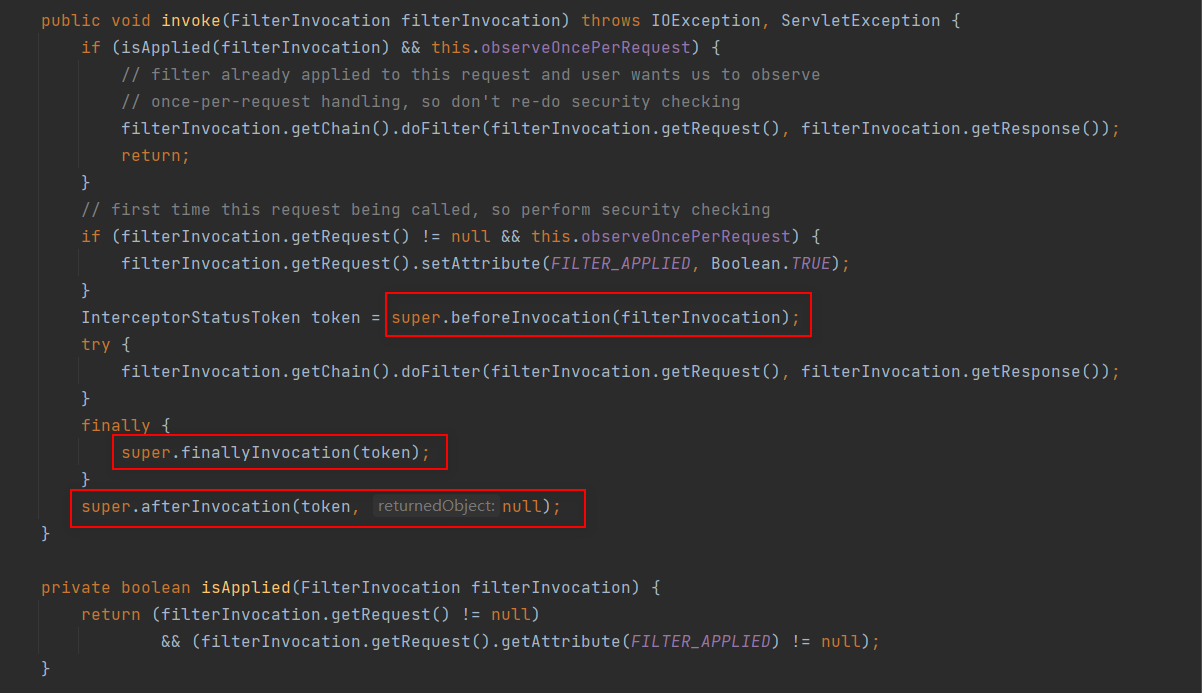
基本都是调用父类的方法,那下面就重点看下父类 AbstractSecurityInterceptor 中相关方法

为安全对象实现安全拦截的抽象类。
AbstractSecurityInterceptor 将确保安全拦截器的正确启动配置。 它还将实现对安全对象调用的正确处理,即:
- 从 SecurityContextHolder 获取 Authentication 对象。
- 通过在SecurityMetadataSource中查找安全对象请求,确定请求是与安全调用还是公共调用相关(PS:简单地来讲,就是看一下请求的资源是不是受保护的,受保护的就是安全调用,就要权限,不受保护的就不需要权限就可以访问)。
- 对于受保护的调用(有一个用于安全对象调用的 ConfigAttributes 列表):
- 如果 Authentication.isAuthenticated() 返回 false,或者 alwaysReauthenticate 为 true,则根据配置的 AuthenticationManager 对请求进行身份验证。 通过身份验证后,将 SecurityContextHolder 上的 Authentication 对象替换为返回值。
- 根据配置的AccessDecisionManager授权请求。
- 通过配置的RunAsManager执行任何run-as替换。
- 将控制权传递回具体的子类,它实际上将继续执行对象。返回一个 InterceptorStatusToken 以便在子类完成对象的执行后,其 finally 子句可以确保 AbstractSecurityInterceptor 被调用并使用 finallyInvocation(InterceptorStatusToken) 正确处理。
- 具体的子类将通过 afterInvocation(InterceptorStatusToken, Object) 方法重新调用 AbstractSecurityInterceptor。
- 如果 RunAsManager 替换了 Authentication 对象,则将 SecurityContextHolder 返回到调用 AuthenticationManager 后存在的对象。
- 如果定义了AfterInvocationManager,则调用它并允许它替换将要返回给调用者的对象。
- 对于公开的调用(安全对象调用没有 ConfigAttributes):
- 如上所述,具体的子类将返回一个 InterceptorStatusToken,在执行完安全对象后,该 InterceptorStatusToken 随后被重新呈现给 AbstractSecurityInterceptor。 AbstractSecurityInterceptor 在它的 afterInvocation(InterceptorStatusToken, Object) 被调用时不会采取进一步的行动。
- 控制再次返回到具体的子类,以及应该返回给调用者的对象。然后子类会将该结果或异常返回给原始调用者。
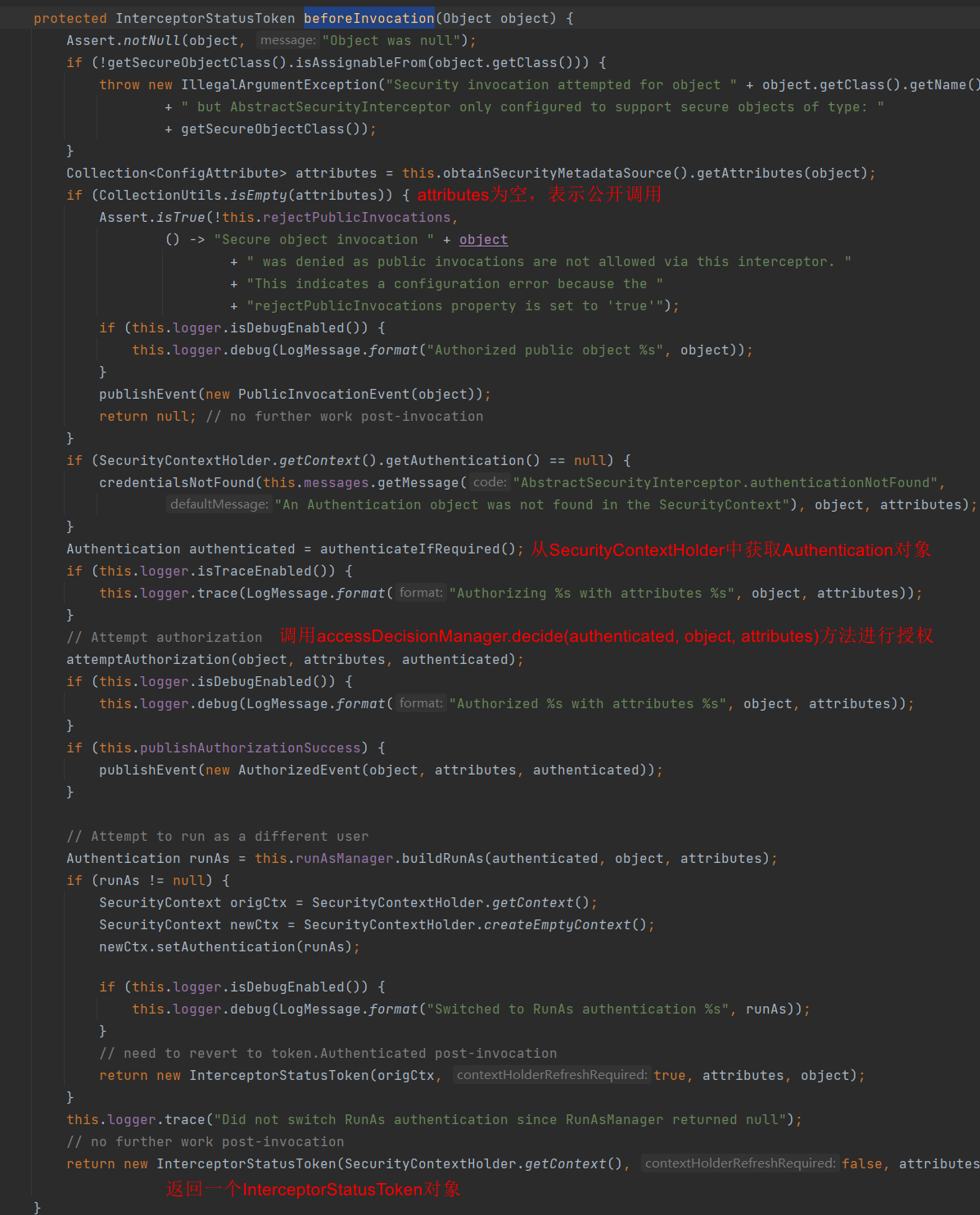
下面具体来看

从这里我们可以知道返回null和空集合是一样的。
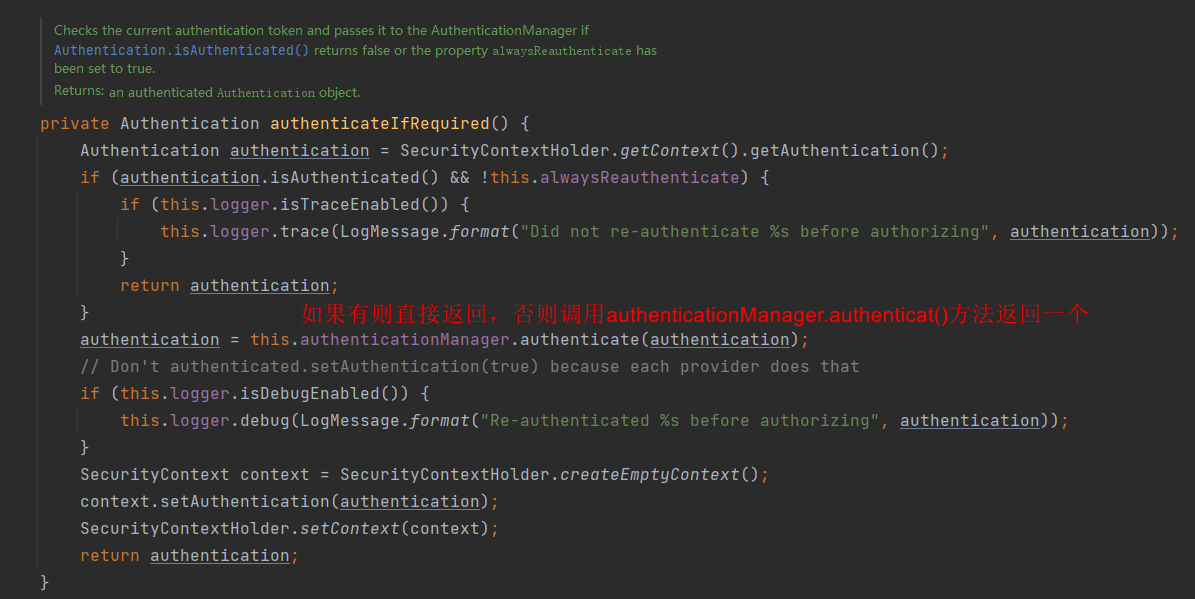
接下来看授权

这是我们要重点关注的,可以看到,授权靠的是 accessDecisionManager.decide(authenticated, object, attributes)
因此,我们想要实现自己的基于请求Url的授权只需自定义一个 AccessDecisionManager 即可
接下来,我们来具体实现一下
2. 自定义基于url的授权
先把Spring Security授权的大致流程流程摆在这儿:
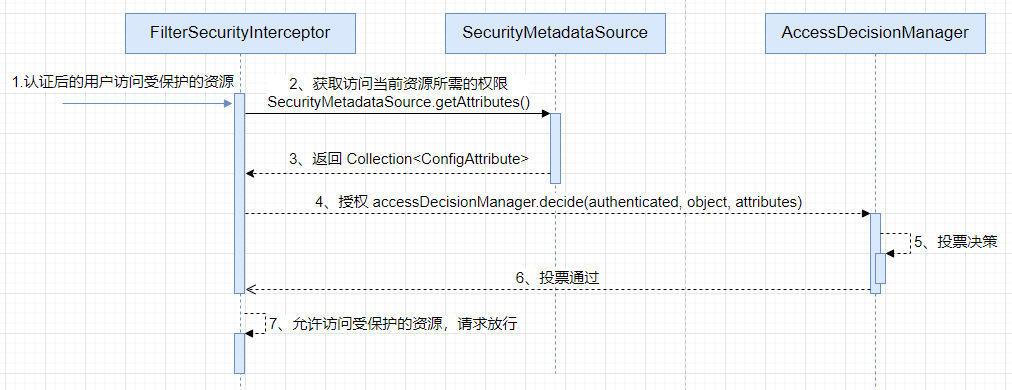
自定义FilterInvocationSecurityMetadataSource
package com.example.security.core;
import com.example.security.service.SysPermissionService;
import org.springframework.beans.factory.annotation.Autowired;
import org.springframework.security.access.ConfigAttribute;
import org.springframework.security.access.SecurityConfig;
import org.springframework.security.web.FilterInvocation;
import org.springframework.security.web.access.intercept.FilterInvocationSecurityMetadataSource;
import org.springframework.stereotype.Component;
import org.springframework.util.AntPathMatcher;
import java.util.ArrayList;
import java.util.Collection;
import java.util.List;
import java.util.Map;
/**
* @Author ChengJianSheng
* @Date 2021/12/2
*/
@Component
public class MyFilterSecurityMetadataSource implements FilterInvocationSecurityMetadataSource {
@Autowired
private SysPermissionService sysPermissionService;
private final AntPathMatcher antPathMatcher = new AntPathMatcher();
@Override
public Collection<ConfigAttribute> getAttributes(Object object) throws IllegalArgumentException {
FilterInvocation fi = (FilterInvocation) object;
String url = fi.getRequestUrl();
String httpMethod = fi.getRequest().getMethod();
List<ConfigAttribute> attributes = new ArrayList<>();
Map<String, String> urlRoleMap = sysPermissionService.getAllUrlRole();
for (Map.Entry<String, String> entry : urlRoleMap.entrySet()) {
if (antPathMatcher.match(entry.getKey(), url)) {
return SecurityConfig.createList(entry.getValue());
}
}
// 返回null和空列表是一样的,都表示当前访问的资源不需要权限,所有人都可以访问
return attributes;
// return null;
}
@Override
public Collection<ConfigAttribute> getAllConfigAttributes() {
return null;
}
@Override
public boolean supports(Class<?> clazz) {
return FilterInvocation.class.isAssignableFrom(clazz);
}
}这里需要说明一下,其实Spring Security里面说的role不一定表示的是我们自己建的那个角色表,我们可以这样理解,就是它这里的所谓role只是一个权限标识。我们在建表的时候,通常最基本的是5张表(用户表、角色表、权限表、用户角色关系表、角色权限关系表),我们可以把受保护的资源(通常是一个url)与角色关联起来,建立哪些角色可以访问哪些资源,也可以直接判断资源的权限(通常是权限编码/标识)。

只要有这个关系,剩下的就是写法不同而已。如果你把role理解成资源的权限标识的话,那么返回的Collection<ConfigAttribute>中就最多有一个元素,如果理解成角色的话,那么可能有多个元素。就这么点儿东西,写法不同而已,本质是一样的。
自定义AccessDecisionManager
package com.example.security.core;
import org.springframework.security.access.AccessDecisionManager;
import org.springframework.security.access.AccessDeniedException;
import org.springframework.security.access.ConfigAttribute;
import org.springframework.security.authentication.InsufficientAuthenticationException;
import org.springframework.security.core.Authentication;
import org.springframework.security.core.GrantedAuthority;
import org.springframework.stereotype.Component;
import java.util.Collection;
/**
* @Author ChengJianSheng
* @Date 2021/12/2
*/
@Component
public class MyAccessDecisionManager implements AccessDecisionManager {
@Override
public void decide(Authentication authentication, Object object, Collection<ConfigAttribute> configAttributes) throws AccessDeniedException, InsufficientAuthenticationException {
Collection<? extends GrantedAuthority> authorities = authentication.getAuthorities();
System.out.println(authorities);
System.out.println(configAttributes);
// 查看当前用户是否有对应的权限访问该保护资源
for (ConfigAttribute attribute : configAttributes) {
for (GrantedAuthority authority : authorities) {
if (authority.getAuthority().equals(attribute.getAttribute())) {
return;
}
}
}
throw new AccessDeniedException("Access is denied");
}
@Override
public boolean supports(ConfigAttribute attribute) {
return true;
}
@Override
public boolean supports(Class<?> clazz) {
return true;
}
}
decide方法的三个参数,依次表示:
- 调用者(非空)
- 被调用的安全对象
- 与被调用的安全对象关联的配置属性
配置WebSecurityConfig
package com.example.security.config;
import com.example.security.core.MyAccessDecisionManager;
import com.example.security.core.MyFilterSecurityMetadataSource;
import com.example.security.core.MyUserDetailsService;
import org.springframework.beans.factory.annotation.Autowired;
import org.springframework.context.annotation.Bean;
import org.springframework.context.annotation.Configuration;
import org.springframework.security.config.annotation.ObjectPostProcessor;
import org.springframework.security.config.annotation.authentication.builders.AuthenticationManagerBuilder;
import org.springframework.security.config.annotation.web.builders.HttpSecurity;
import org.springframework.security.config.annotation.web.configuration.WebSecurityConfigurerAdapter;
import org.springframework.security.crypto.bcrypt.BCryptPasswordEncoder;
import org.springframework.security.crypto.password.PasswordEncoder;
import org.springframework.security.web.access.intercept.FilterSecurityInterceptor;
/**
* @Author ChengJianSheng
* @Date 2021/12/6
*/
@Configuration
public class WebSecurityConfig extends WebSecurityConfigurerAdapter {
@Autowired
private MyUserDetailsService myUserDetailsService;
@Autowired
private MyAccessDecisionManager myAccessDecisionManager;
@Autowired
private MyFilterSecurityMetadataSource myFilterSecurityMetadataSource;
@Override
protected void configure(AuthenticationManagerBuilder auth) throws Exception {
auth.userDetailsService(myUserDetailsService).passwordEncoder(passwordEncoder());
}
@Override
protected void configure(HttpSecurity http) throws Exception {
http.formLogin()
.and()
.authorizeRequests()
.withObjectPostProcessor(new ObjectPostProcessor<FilterSecurityInterceptor>() {
@Override
public <O extends FilterSecurityInterceptor> O postProcess(O object) {
object.setSecurityMetadataSource(myFilterSecurityMetadataSource);
object.setAccessDecisionManager(myAccessDecisionManager);
return object;
}
})
.anyRequest().authenticated();
}
@Bean
public PasswordEncoder passwordEncoder() {
return new BCryptPasswordEncoder();
}
}其它不重要的就直接贴出来了
pom.xml
<?xml version="1.0" encoding="UTF-8"?>
<project xmlns="http://maven.apache.org/POM/4.0.0" xmlns:xsi="http://www.w3.org/2001/XMLSchema-instance"
xsi:schemaLocation="http://maven.apache.org/POM/4.0.0 https://maven.apache.org/xsd/maven-4.0.0.xsd">
<modelVersion>4.0.0</modelVersion>
<parent>
<groupId>org.springframework.boot</groupId>
<artifactId>spring-boot-starter-parent</artifactId>
<version>2.6.1</version>
<relativePath/> <!-- lookup parent from repository -->
</parent>
<groupId>com.example</groupId>
<artifactId>security-demo</artifactId>
<version>0.0.1-SNAPSHOT</version>
<name>security-demo</name>
<properties>
<java.version>1.8</java.version>
</properties>
<dependencies>
<dependency>
<groupId>org.springframework.boot</groupId>
<artifactId>spring-boot-starter-data-jpa</artifactId>
</dependency>
<dependency>
<groupId>org.springframework.boot</groupId>
<artifactId>spring-boot-starter-security</artifactId>
</dependency>
<dependency>
<groupId>org.springframework.boot</groupId>
<artifactId>spring-boot-starter-web</artifactId>
</dependency>
<dependency>
<groupId>mysql</groupId>
<artifactId>mysql-connector-java</artifactId>
<scope>runtime</scope>
</dependency>
<dependency>
<groupId>org.projectlombok</groupId>
<artifactId>lombok</artifactId>
<optional>true</optional>
</dependency>
<dependency>
<groupId>org.springframework.boot</groupId>
<artifactId>spring-boot-starter-test</artifactId>
<scope>test</scope>
</dependency>
<dependency>
<groupId>org.springframework.security</groupId>
<artifactId>spring-security-test</artifactId>
<scope>test</scope>
</dependency>
</dependencies>
<build>
<plugins>
<plugin>
<groupId>org.springframework.boot</groupId>
<artifactId>spring-boot-maven-plugin</artifactId>
<configuration>
<excludes>
<exclude>
<groupId>org.projectlombok</groupId>
<artifactId>lombok</artifactId>
</exclude>
</excludes>
</configuration>
</plugin>
</plugins>
</build>
</project>
application.yml
spring:
datasource:
url: jdbc:mysql://localhost:3306/demo126?serverTimezone=Asia/Shanghai&characterEncoding=utf8&useSSL=false
driver-class-name: com.mysql.cj.jdbc.Driver
username: root
password: 123456
jpa:
database: mysql
show-sql: true
SysPermissionEntity.java
package com.example.security.entity;
import lombok.Getter;
import lombok.Setter;
import javax.persistence.*;
import java.io.Serializable;
/**
* @Author ChengJianSheng
* @Date 2021/12/6
*/
@Getter
@Setter
@Entity
@Table(name = "sys_permission")
public class SysPermissionEntity implements Serializable {
@Id
@GeneratedValue(strategy = GenerationType.AUTO)
private Integer id;
/** 权限编码(标识) */
private String code;
/** 权限名称 */
private String name;
/** 权限URL */
private String url;
}
SysRoleEntity.java
package com.example.security.entity;
import lombok.Getter;
import lombok.Setter;
import javax.persistence.*;
import java.io.Serializable;
import java.util.Set;
/**
* @Author ChengJianSheng
* @Date 2021/12/6
*/
@Getter
@Setter
@Entity
@Table(name = "sys_role")
public class SysRoleEntity implements Serializable {
@Id
@GeneratedValue(strategy = GenerationType.AUTO)
private Integer id;
/** 角色编码 */
private String code;
/** 角色名称 */
private String name;
@ManyToMany
@JoinTable(name = "sys_role_permission", joinColumns = {@JoinColumn(name = "role_id")}, inverseJoinColumns = {@JoinColumn(name = "permission_id")})
private Set<SysPermissionEntity> permissions;
}
SysUserEntity.java
package com.example.security.entity;
import lombok.Getter;
import lombok.Setter;
import javax.persistence.*;
import java.io.Serializable;
import java.util.Set;
/**
* @Author ChengJianSheng
* @Date 2021/12/6
*/
@Getter
@Setter
@Entity
@Table(name = "sys_user")
public class SysUserEntity implements Serializable {
@Id
@GeneratedValue(strategy = GenerationType.AUTO)
private Integer id;
/** 用户名 */
private String username;
/** 密码 */
private String password;
@ManyToMany
@JoinTable(name = "sys_user_role",
joinColumns = {@JoinColumn(name = "user_id")},
inverseJoinColumns = {@JoinColumn(name = "role_id")})
private Set<SysRoleEntity> roles;
}
SysUserRepository.java
package com.example.security.repository;
import com.example.security.entity.SysUserEntity;
import org.springframework.data.jpa.repository.JpaRepository;
import org.springframework.data.jpa.repository.JpaSpecificationExecutor;
/**
* @Author ChengJianSheng
* @Date 2021/12/6
*/
public interface SysUserRepository extends JpaRepository<SysUserEntity, Integer>, JpaSpecificationExecutor<SysUserEntity> {
SysUserEntity findByUsername(String username);
}
SysPermissionServiceImpl.java
package com.example.security.service.impl;
import com.example.security.entity.SysPermissionEntity;
import com.example.security.repository.SysPermissionRepository;
import com.example.security.service.SysPermissionService;
import org.springframework.stereotype.Service;
import javax.annotation.Resource;
import java.util.List;
import java.util.Map;
import java.util.stream.Collectors;
/**
* @Author ChengJianSheng
* @Date 2021/12/6
*/
@Service
public class SysPermissionServiceImpl implements SysPermissionService {
@Resource
private SysPermissionRepository sysPermissionRepository;
@Override
public Map<String, String> getAllUrlRole() {
List<SysPermissionEntity> list = sysPermissionRepository.findAll();
return list.stream().collect(Collectors.toMap(SysPermissionEntity::getUrl, SysPermissionEntity::getCode));
}
}
MyUserDetails.java
package com.example.security.domain;
import lombok.AllArgsConstructor;
import lombok.NoArgsConstructor;
import org.springframework.security.core.GrantedAuthority;
import org.springframework.security.core.authority.SimpleGrantedAuthority;
import org.springframework.security.core.userdetails.UserDetails;
import java.util.Collection;
import java.util.Set;
/**
* @Author ChengJianSheng
* @Date 2021/12/6
*/
@NoArgsConstructor
@AllArgsConstructor
public class MyUserDetails implements UserDetails {
private String username;
private String password;
private boolean enabled;
private Set<SimpleGrantedAuthority> authorities;
@Override
public Collection<? extends GrantedAuthority> getAuthorities() {
return authorities;
}
@Override
public String getPassword() {
return password;
}
@Override
public String getUsername() {
return username;
}
@Override
public boolean isAccountNonExpired() {
return true;
}
@Override
public boolean isAccountNonLocked() {
return true;
}
@Override
public boolean isCredentialsNonExpired() {
return true;
}
@Override
public boolean isEnabled() {
return enabled;
}
}
MyUserDetailsService.java
package com.example.security.core;
import com.example.security.domain.MyUserDetails;
import com.example.security.entity.SysPermissionEntity;
import com.example.security.entity.SysUserEntity;
import com.example.security.repository.SysUserRepository;
import org.springframework.security.core.authority.SimpleGrantedAuthority;
import org.springframework.security.core.userdetails.UserDetails;
import org.springframework.security.core.userdetails.UserDetailsService;
import org.springframework.security.core.userdetails.UsernameNotFoundException;
import org.springframework.stereotype.Service;
import javax.annotation.Resource;
import javax.transaction.Transactional;
import java.util.Set;
import java.util.stream.Collectors;
/**
* @Author ChengJianSheng
* @Date 2021/12/6
*/
@Transactional
@Service
public class MyUserDetailsService implements UserDetailsService {
@Resource
private SysUserRepository sysUserRepository;
@Override
public UserDetails loadUserByUsername(String username) throws UsernameNotFoundException {
SysUserEntity sysUserEntity = sysUserRepository.findByUsername(username);
if (null == sysUserEntity) {
throw new UsernameNotFoundException("用户不存在");
}
Set<SimpleGrantedAuthority> authorities = sysUserEntity.getRoles().stream()
.flatMap(roleId->roleId.getPermissions().stream())
.map(SysPermissionEntity::getCode)
.map(SimpleGrantedAuthority::new)
.collect(Collectors.toSet());
return new MyUserDetails(sysUserEntity.getUsername(), sysUserEntity.getPassword(), true, authorities);
}
}
HelloController.java
package com.example.security.controller;
import org.springframework.web.bind.annotation.GetMapping;
import org.springframework.web.bind.annotation.RequestMapping;
import org.springframework.web.bind.annotation.RestController;
/**
* @Author ChengJianSheng
* @Date 2021/12/6
*/
@RestController
@RequestMapping("/hello")
public class HelloController {
@GetMapping("/sayHello")
public String sayHello() {
return "Hello";
}
@GetMapping("/sayHi")
public String sayHi() {
return "Hi";
}
}


数据库脚本如下
SET NAMES utf8mb4;
SET FOREIGN_KEY_CHECKS = 0;
-- ----------------------------
-- Table structure for sys_permission
-- ----------------------------
DROP TABLE IF EXISTS `sys_permission`;
CREATE TABLE `sys_permission` (
`id` int(11) NOT NULL AUTO_INCREMENT,
`code` varchar(255) CHARACTER SET utf8 COLLATE utf8_general_ci NOT NULL COMMENT '权限编码(标识)',
`name` varchar(255) CHARACTER SET utf8 COLLATE utf8_general_ci NOT NULL COMMENT '权限名称',
`url` varchar(255) CHARACTER SET utf8 COLLATE utf8_general_ci NOT NULL COMMENT '权限URL',
PRIMARY KEY (`id`) USING BTREE
) ENGINE = InnoDB AUTO_INCREMENT = 5 CHARACTER SET = utf8 COLLATE = utf8_general_ci ROW_FORMAT = Dynamic;
-- ----------------------------
-- Records of sys_permission
-- ----------------------------
INSERT INTO `sys_permission` VALUES (1, 'home', '首页', '/home/**');
INSERT INTO `sys_permission` VALUES (2, 'user:add', '添加用户', '/user/add');
INSERT INTO `sys_permission` VALUES (3, 'user:delete', '删除用户', '/user/delete');
INSERT INTO `sys_permission` VALUES (4, 'hello:sayHello', '打招呼', '/hello/sayHello');
-- ----------------------------
-- Table structure for sys_role
-- ----------------------------
DROP TABLE IF EXISTS `sys_role`;
CREATE TABLE `sys_role` (
`id` int(11) NOT NULL AUTO_INCREMENT,
`code` varchar(255) CHARACTER SET utf8 COLLATE utf8_general_ci NOT NULL COMMENT '角色编码',
`name` varchar(255) CHARACTER SET utf8 COLLATE utf8_general_ci NOT NULL COMMENT '角色名称',
PRIMARY KEY (`id`) USING BTREE
) ENGINE = InnoDB AUTO_INCREMENT = 4 CHARACTER SET = utf8 COLLATE = utf8_general_ci ROW_FORMAT = Dynamic;
-- ----------------------------
-- Records of sys_role
-- ----------------------------
INSERT INTO `sys_role` VALUES (1, 'employee', '员工');
INSERT INTO `sys_role` VALUES (2, 'engineer', '工程师');
INSERT INTO `sys_role` VALUES (3, 'leader', '组长');
-- ----------------------------
-- Table structure for sys_role_permission
-- ----------------------------
DROP TABLE IF EXISTS `sys_role_permission`;
CREATE TABLE `sys_role_permission` (
`id` int(11) NOT NULL AUTO_INCREMENT,
`role_id` int(11) NOT NULL COMMENT '角色ID',
`permission_id` int(11) NOT NULL COMMENT '权限ID',
PRIMARY KEY (`id`) USING BTREE
) ENGINE = InnoDB AUTO_INCREMENT = 8 CHARACTER SET = utf8 COLLATE = utf8_general_ci ROW_FORMAT = Dynamic;
-- ----------------------------
-- Records of sys_role_permission
-- ----------------------------
INSERT INTO `sys_role_permission` VALUES (1, 1, 1);
INSERT INTO `sys_role_permission` VALUES (2, 2, 1);
INSERT INTO `sys_role_permission` VALUES (3, 2, 2);
INSERT INTO `sys_role_permission` VALUES (4, 3, 1);
INSERT INTO `sys_role_permission` VALUES (5, 3, 2);
INSERT INTO `sys_role_permission` VALUES (6, 3, 3);
INSERT INTO `sys_role_permission` VALUES (7, 3, 4);
-- ----------------------------
-- Table structure for sys_user
-- ----------------------------
DROP TABLE IF EXISTS `sys_user`;
CREATE TABLE `sys_user` (
`id` int(11) NOT NULL AUTO_INCREMENT,
`username` varchar(255) CHARACTER SET utf8 COLLATE utf8_general_ci NOT NULL COMMENT '用户名',
`password` varchar(255) CHARACTER SET utf8 COLLATE utf8_general_ci NOT NULL COMMENT '密码',
PRIMARY KEY (`id`) USING BTREE
) ENGINE = InnoDB AUTO_INCREMENT = 2 CHARACTER SET = utf8 COLLATE = utf8_general_ci ROW_FORMAT = Dynamic;
-- ----------------------------
-- Records of sys_user
-- ----------------------------
INSERT INTO `sys_user` VALUES (1, 'zhangsan', '$2a$10$e4wFsFHQCNjPe5tTJMPkRuKGwmMGC45pfjMupY9nwbTuoKQ0bKc/u');
-- ----------------------------
-- Table structure for sys_user_role
-- ----------------------------
DROP TABLE IF EXISTS `sys_user_role`;
CREATE TABLE `sys_user_role` (
`id` int(11) NOT NULL AUTO_INCREMENT,
`user_id` int(11) NOT NULL COMMENT '用户ID',
`role_id` int(11) NOT NULL COMMENT '角色ID',
PRIMARY KEY (`id`) USING BTREE
) ENGINE = InnoDB AUTO_INCREMENT = 4 CHARACTER SET = utf8 COLLATE = utf8_general_ci ROW_FORMAT = Dynamic;
-- ----------------------------
-- Records of sys_user_role
-- ----------------------------
INSERT INTO `sys_user_role` VALUES (1, 1, 1);
INSERT INTO `sys_user_role` VALUES (2, 1, 2);
INSERT INTO `sys_user_role` VALUES (3, 1, 3);
SET FOREIGN_KEY_CHECKS = 1;浏览器访问 http://localhost:8080/hello/sayHi 正常返回,不用登录,因为没有在sys_permission表中配置该资源,也就是说它不是一个受保护的资源(公开资源)
访问http://localhost:8080/hello/sayHello则需要先登录,用zhangsan登录成功以后正确返回
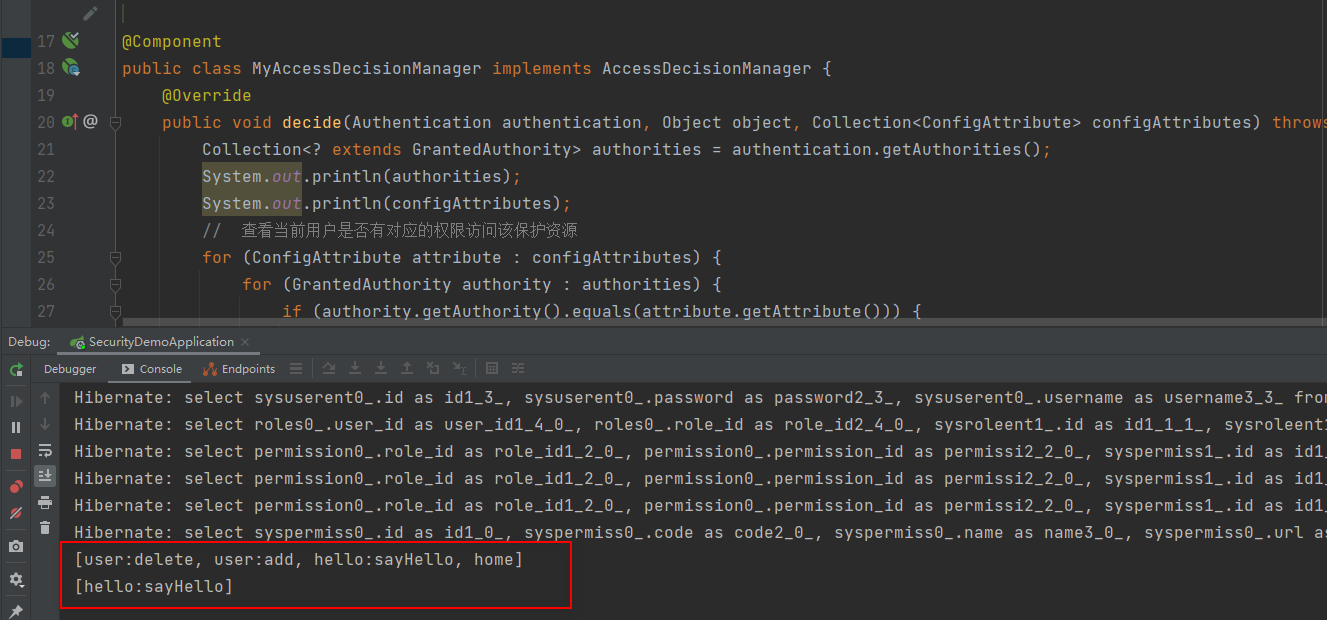

项目结构如下

Spring Security 基于URL的权限判断的更多相关文章
- Spring Security 动态url权限控制(三)
一.前言 本篇文章将讲述Spring Security 动态分配url权限,未登录权限控制,登录过后根据登录用户角色授予访问url权限 基本环境 spring-boot 2.1.8 mybatis-p ...
- spring security 3.1 实现权限控制
spring security 3.1 实现权限控制 简单介绍:spring security 实现的权限控制,能够分别保护后台方法的管理,url连接訪问的控制,以及页面元素的权限控制等, secur ...
- 在ASP.NET MVC中实现基于URL的权限控制
本示例演示了在ASP.NET MVC中进行基于URL的权限控制,由于是基于URL进行控制的,所以只能精确到页.这种权限控制的优点是可以在已有的项目上改动极少的代码来增加权限控制功能,和项目本身的耦合度 ...
- 基于Spring Security和 JWT的权限系统设计
写在前面 关于 Spring Security Web系统的认证和权限模块也算是一个系统的基础设施了,几乎任何的互联网服务都会涉及到这方面的要求.在Java EE领域,成熟的安全框架解决方案一般有 A ...
- springboot整合security实现基于url的权限控制
权限控制基本上是任何一个web项目都要有的,为此spring为我们提供security模块来实现权限控制,网上找了很多资料,但是提供的demo代码都不能完全满足我的需求,因此自己整理了一版. 在上代码 ...
- spring boot系列--spring security (基于数据库)登录和权限控制
先说一下AuthConfig.java Spring Security的主要配置文件之一 AuthConfig 1 @Configuration 2 @EnableWebSecurity 3 publ ...
- Spring Security(15)——权限鉴定结构
目录 1.1 权限 1.2 调用前的处理 1.2.1 AccessDecisionManager 1.2.2 基于投票的AccessDecisionManager实 ...
- Spring Security(14)——权限鉴定基础
目录 1.1 Spring Security的AOP Advice思想 1.2 AbstractSecurityInterceptor 1.2.1 ConfigAttribute ...
- Spring Security基于Java配置
Maven依赖 <dependencies> <!-- ... other dependency elements ... --> <dependency> < ...
随机推荐
- Python:Ubuntu上使用pip安装opencv-python出现错误
Ubuntu 18.04 上 使用 pip 安装 opencv-python,出现的错误如下: 1 ~$: pip install opencv-python -i https://pypi.tuna ...
- 字符串与模式匹配算法(五):BMH算法
一.BMH算法介绍 在BM算法的实际应用中,坏字符偏移函数的应用次数要远远超过好后缀偏移函数的应用次数,坏字符偏移函数在匹配过程中起着移动指针的主导作用.在实际匹配过程,只是用坏字符偏移函数也非常有效 ...
- 51nod_1001 数组中和等于K的数对(二分)
题意: 给出一个整数K和一个无序数组A,A的元素为N个互不相同的整数,找出数组A中所有和等于K的数对.例如K = 8,数组A:{-1,6,5,3,4,2,9,0,8},所有和等于8的数对包括(-1,9 ...
- PHP笔记3__简易计算器
<?php header("Content-type: text/html; charset=utf-8"); error_reporting(E_ALL & ~E_ ...
- python 处理xml 数据
1 import xml.sax 2 import xml.sax.handler 3 4 # python 处理xml 数据 类,将xml数据转化为字典 5 ''' 6 原数据:<?xml v ...
- java实现rsa加密算法【5min快速应用教程】
该篇文章的主要目的是让读者能够迅速应用到项目中,想要了解详细的rsa加密算法的,可以百度找到更多原理.深度分析的文章. RSA算法是一种非对称密码算法,所谓非对称,就是指该算法需要一对密钥,使用其中一 ...
- SimpleNVR流媒体服务系统录像功能解析
录像的回放与观看是许多人在使用视频监控时必不可少的需求.人不可能每时每刻都观看视频,而录像能对摄像机的视频信息进行存储,方便用户的后期回放查看,因此,SimpleNVR的录像功能应运而生. ...
- [python]基于windows搭建django项目
1.首先我的环境用到的库版本如下,若下载直接pip即可 pip3 install Django==2.0.6pip3 install djangorestframework==3.8.2pip3 in ...
- dedecms被挂马排毒的过程
又经历了一次dedecms被挂马排毒的过程,排毒过程在这里跟大家分享一下. 挂马之后,网站的表现形式: 直接访问网站没有任何问题,从百度搜索的关键词访问网站,就跳转到另外一个网站. 根据我原来的排毒经 ...
- 15. mac安装多版本jdk
一.jdk下载地址 jdk官网下载地址:http://jdk.java.net/archive/ 二.安装jdk Mac的JDK都是安装到一个指定目录的:/Library/Java/JavaVirtu ...
